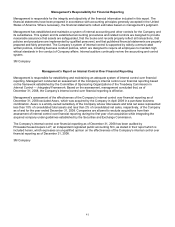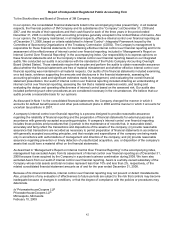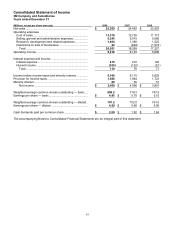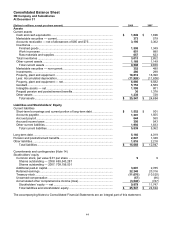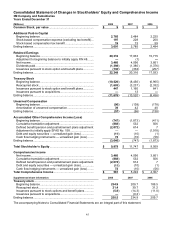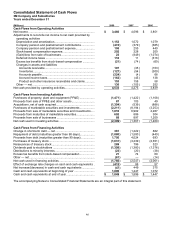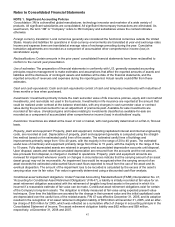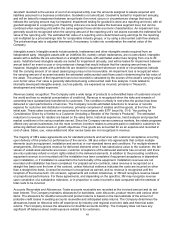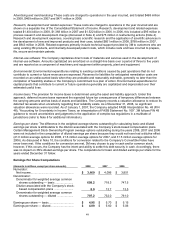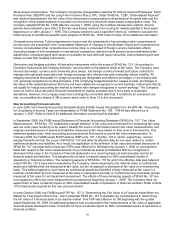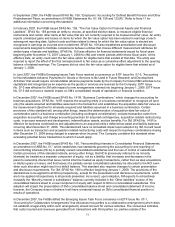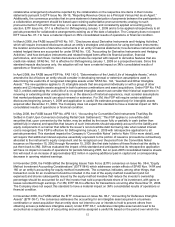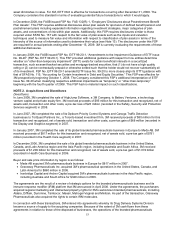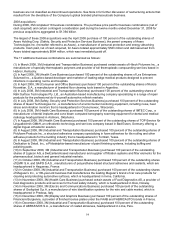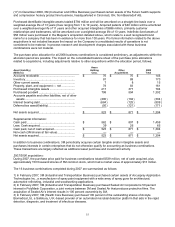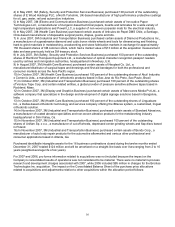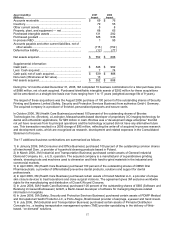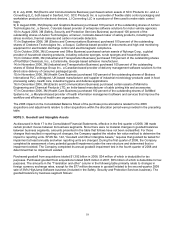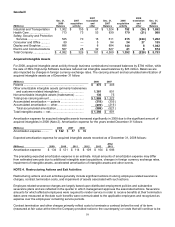3M 2008 Annual Report Download - page 57
Download and view the complete annual report
Please find page 57 of the 2008 3M annual report below. You can navigate through the pages in the report by either clicking on the pages listed below, or by using the keyword search tool below to find specific information within the annual report.51
In September 2006, the FASB issued SFAS No. 158, “Employers’ Accounting for Defined Benefit Pension and Other
Postretirement Plans, an amendment of FASB Statements No. 87, 88, 106 and 132(R).” Refer to Note 11 for
additional information concerning this standard.
In February 2007, the FASB issued SFAS No. 159, “The Fair Value Option for Financial Assets and Financial
Liabilities”. SFAS No. 159 permits an entity to choose, at specified election dates, to measure eligible financial
instruments and certain other items at fair value that are not currently required to be measured at fair value. An entity
reports unrealized gains and losses on items for which the fair value option has been elected in earnings at each
subsequent reporting date. Upfront costs and fees related to items for which the fair value option is elected are
recognized in earnings as incurred and not deferred. SFAS No. 159 also established presentation and disclosure
requirements designed to facilitate comparisons between entities that choose different measurement attributes for
similar types of assets and liabilities. SFAS No. 159 was effective for financial statements issued for fiscal years
beginning after November 15, 2007 (January 1, 2008 for 3M) and interim periods within those fiscal years. At the
effective date, an entity could elect the fair value option for eligible items that existed at that date. The entity was
required to report the effect of the first remeasurement to fair value as a cumulative-effect adjustment to the opening
balance of retained earnings. The Company did not elect the fair value option for eligible items that existed as of
January 1, 2008.
In June 2007, the FASB’s Emerging Issues Task Force reached a consensus on EITF Issue No. 07-3, “Accounting
for Nonrefundable Advance Payments for Goods or Services to Be Used in Future Research and Development
Activities” that would require nonrefundable advance payments made by the Company for future R&D activities to be
capitalized and recognized as an expense as the goods or services are received by the Company. EITF Issue
No. 07-3 was effective for 3M with respect to new arrangements entered into beginning January 1, 2008. EITF Issue
No. 07-3 did not have a material impact on 3M’s consolidated results of operations or financial condition.
In December 2007, the FASB issued SFAS No. 141R, “Business Combinations,” which changes the accounting for
business acquisitions. SFAS No. 141R requires the acquiring entity in a business combination to recognize all (and
only) the assets acquired and liabilities assumed in the transaction and establishes the acquisition-date fair value as
the measurement objective for all assets acquired and liabilities assumed in a business combination. Certain
provisions of this standard will, among other things, impact the determination of acquisition-date fair value of
consideration paid in a business combination (including contingent consideration); exclude transaction costs from
acquisition accounting; and change accounting practices for acquired contingencies, acquisition-related restructuring
costs, in-process research and development, indemnification assets, and tax benefits. For 3M, SFAS No. 141R is
effective for business combinations and adjustments to an acquired entity’s deferred tax asset and liability balances
occurring after December 31, 2008. This standard will have no immediate impact upon adoption by 3M, but will result
in items such as transaction and acquisition related-restructuring costs with respect to business combinations closing
after December 31, 2008 being charged to expense when incurred. The Company considers this standard when
evaluating potential future transactions to which it would apply.
In December 2007, the FASB issued SFAS No. 160, “Noncontrolling Interests in Consolidated Financial Statements,
an amendment of ARB No. 51,” which establishes new standards governing the accounting for and reporting of
noncontrolling interests (NCIs) in partially owned consolidated subsidiaries and the loss of control of subsidiaries.
Certain provisions of this standard indicate, among other things, that NCIs (previously referred to as minority
interests) be treated as a separate component of equity, not as a liability; that increases and decreases in the
parent’s ownership interest that leave control intact be treated as equity transactions, rather than as step acquisitions
or dilution gains or losses; and that losses of a partially owned consolidated subsidiary be allocated to the NCI even
when such allocation might result in a deficit balance. This standard also requires changes to certain presentation
and disclosure requirements. For 3M, SFAS No. 160 is effective beginning January 1, 2009. The provisions of the
standard are to be applied to all NCIs prospectively, except for the presentation and disclosure requirements, which
are to be applied retrospectively to all periods presented. As a result, upon adoption, 3M expects to retroactively
reclassify the “Minority interest in subsidiaries” balance currently included in the “Other liabilities” section of the
consolidated balance sheet to a new component of equity with respect to NCIs in consolidated subsidiaries. This
adoption will impact the presentation of 3M’s consolidated balance sheet and consolidated statement of income;
however, the Company does not believe it will have a material impact on 3M’s consolidated financial position or
results of operations.
In December 2007, the FASB ratified the Emerging Issues Task Force consensus on EITF Issue No. 07-1,
“Accounting for Collaborative Arrangements” that discusses how parties to a collaborative arrangement (which does
not establish a legal entity within such arrangement) should account for various activities. The consensus indicates
that costs incurred and revenues generated from transactions with third parties (i.e. parties outside of the


